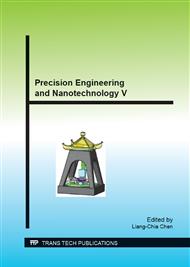p.384
p.392
p.398
p.402
p.411
p.417
p.423
p.430
p.437
A New Prediction Model for Thermally Induced Errors of a Turning Center
Abstract:
Thermally induced errors and geometric errors are two main sources that affect the machine tool accuracy when machining. In the last decade, real time compensation method had received wide attention for its ability to reduce the thermal error cost–effectively. Although real-time thermal error compensation techniques have been successfully demonstrated in laboratories, several difficulties hinder its widespread application. The selection of temperature variables and the setup of the error measurement system are the most critical ones among these difficulties. In this paper, a new on line measurement system and a new model that predicts the thermal error of a turning center are developed. The on-line measurement system using a Renishaw’s LT02S probe system is capable of measuring thermal error of a CNC turning center in real cutting conditions. The neural network uses the cutting conditions as the mapping inputs to avoid problems occurred in the traditional temperature-error mapping model. Results show the proposed measurement system and prediction model can be used to accurately estimate the thermally induced error in real cutting conditions.
Info:
Periodical:
Pages:
411-416
Citation:
Online since:
August 2014
Authors:
Price:
Сopyright:
© 2015 Trans Tech Publications Ltd. All Rights Reserved
Share:
Citation:


